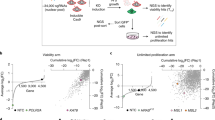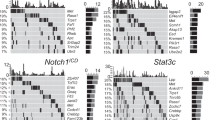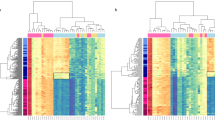Abstract
The gene hypermethylated in cancer-1 (HIC1) encodes a zinc-finger transcription factor1 that belongs to a group of proteins known as the POZ family2. HIC1 is hypermethylated and transcriptionally silent in several types of human cancer1,3,4,5. Homozygous disruption of Hic1 impairs development and results in embryonic and perinatal lethality in mice6. Here we show that mice disrupted in the germ line for only one allele of Hic1 develop many different spontaneous malignant tumors, including a predominance of epithelial cancers in males and lymphomas and sarcomas in females. The complete loss of Hic1 function in the heterozygous mice seems to involve dense methylation of the promoter of the remaining wild-type allele. We conclude that HIC1 is a candidate tumor-suppressor gene for which loss of function in both mouse and human cancers is associated only with epigenetic modifications.
This is a preview of subscription content, access via your institution
Access options
Subscribe to this journal
Receive 12 print issues and online access
$209.00 per year
only $17.42 per issue
Buy this article
- Purchase on Springer Link
- Instant access to full article PDF
Prices may be subject to local taxes which are calculated during checkout





Similar content being viewed by others
Accession codes
References
Wales, M.M. et al. p53 activates expression of HIC-1, a new candidate tumour suppressor gene on 17p13.3. Nat. Med. 1, 570–577 (1995).
Bardwell, V.J. & Treisman, R. The POZ domain: a conserved protein–protein interaction motif. Genes Dev. 8, 1664–1677 (1994).
Fujii, H. et al. Methylation of the HIC-1 candidate tumor suppressor gene in human breast cancer. Oncogene 16, 2159–2164 (1998).
Issa, J.P., Zehnbauer, B.A., Kaufmann, S.H., Biel, M.A. & Baylin, S.B. HIC1 hypermethylation is a late event in hematopoietic neoplasms. Cancer Res. 57, 1678–1681 (1997).
Kanai, Y. et al. DNA hypermethylation at the D17S5 locus and reduced HIC-1 mRNA expression are associated with hepatocarcinogenesis. Hepatology 29, 703–709 (1999).
Carter, M.G. et al. Mice deficient in the candidate tumor suppressor gene Hic1 exhibit developmental defects of structures affected in the Miller–Dieker syndrome. Hum. Mol. Genet. 9, 413–419 (2000).
DePinho, R.A. The age of cancer. Nature 408, 248–254 (2000).
Smith, G.S., Walford, R.L. & Mickey, M.R. Lifespan and incidence of cancer and other diseases in selected long-lived inbred mice and their F1 hybrids. J. Natl. Cancer Inst. 50, 1195–1213 (1973).
Kawada, K. & Ojima, A. Various epithelial and non-epithelial tumors spontaneously occurring in long-lived mice of A/St, CBA, C57BL/6 and their hybrid mice. Acta Pathol. Jpn. 28, 25–39 (1978).
Venkatachalam, S. et al. Retention of wild-type p53 in tumors from p53 heterozygous mice: reduction of p53 dosage can promote cancer formation. EMBO J. 17, 4657–4667 (1998).
Luongo, C., Moser, A.R., Gledhill, S. & Dove, W.F. Loss of Apc+ in intestinal adenomas from Min mice. Cancer Res. 54, 5947–5952 (1994).
Cichowski, K. et al. Mouse models of tumor development in neurofibromatosis type 1. Science 286, 2172–2176 (1999).
Guerardel, C. et al. Identification in the human candidate tumor suppressor gene HIC-1 of a new major alternative TATA-less promoter positively regulated by p53. J. Biol. Chem. 276, 3078–3089 (2001).
Herman, J.G., Graff, J.R., Myohanen, S., Nelkin, B.D. & Baylin, S.B. Methylation-specific PCR: a novel PCR assay for methylation status of CpG islands. Proc. Natl. Acad. Sci. USA 93, 9821–9826 (1996).
Harvey, M. et al. Spontaneous and carcinogen-induced tumorigenesis in p53-deficient mice. Nat. Genet. 5, 225–229 (1993).
Jacks, T. et al. Tumor spectrum analysis in p53-mutant mice. Curr. Biol. 4, 1–7 (1994).
Krimpenfort, P., Quon, K.C., Mooi, W.J., Loonstra, A. & Berns, A. Loss of p16Ink4a confers susceptibility to metastatic melanoma in mice. Nature 413, 83–86 (2001).
Sharpless, N.E. et al. Loss of p16Ink4a with retention of p19Arf predisposes mice to tumorigenesis. Nature 413, 86–91 (2001).
Baylin, S.B. & Herman, J.G. DNA hypermethylation in tumorigenesis: epigenetics joins genetics. Trends Genet. 16, 168–174 (2000).
Baylin, S.B., Belinsky, S.A. & Herman, J.G. Aberrant methylation of gene promoters in cancer—concepts, misconcepts, and promise. J. Natl. Cancer Inst. 92, 1460–1461 (2000).
Baylin, S.B. & Herman, J.G. Promoter hypermethylation—can this change alone ever designate true tumor suppressor gene function? J. Natl. Cancer Inst. 93, 664–665 (2001).
Frommer, M. et al. A genomic sequencing protocol that yields a positive display of 5-methylcytosine residues in individual DNA strands. Proc. Natl. Acad. Sci. USA 89, 1827–1831 (1992).
Bar-Peled, M. & Raikhel, N.V. A method for isolation and purification of specific antibodies to a protein fused to the GST. Anal. Biochem. 241, 140–142 (1996).
Acknowledgements
We thank Y. Akiyama, O. Galm and B. Yang for discussion and suggestions; E. Garrett and S. Piantadosi for statistical advice; P. Wilcox for histology; and L. Meszler for microscopy. This study was supported by a grant from the US National Institutes of Health to S.B.B. C.N.M. was supported by a training grant from the US Public Health Service.
Author information
Authors and Affiliations
Corresponding author
Ethics declarations
Competing interests
J.G.H. and S.B.B. are consultants to Tibotec-Virco. Under licensing agreement between the Johns Hopkins University and Tibotec-Virco, M.S.P. was licensed to Tibotec-Virco and they are entitled to a share of the royalties received by the University from sales of the licensed technology. The terms of these arrangements are being managed by the University in accordance with its conflict of interests policies.
Supplementary information
Rights and permissions
About this article
Cite this article
Chen, W., Zeng, X., Carter, M. et al. Heterozygous disruption of Hic1 predisposes mice to a gender-dependent spectrum of malignant tumors. Nat Genet 33, 197–202 (2003). https://doi.org/10.1038/ng1077
Received:
Accepted:
Published:
Issue Date:
DOI: https://doi.org/10.1038/ng1077
This article is cited by
-
Origins, potency, and heterogeneity of skeletal muscle fibro-adipogenic progenitors—time for new definitions
Skeletal Muscle (2021)
-
The Translational Status of Cancer Liquid Biopsies
Regenerative Engineering and Translational Medicine (2021)
-
Hic1 deletion unleashes quiescent connective tissue stem cells and impairs skeletal muscle regeneration
Journal of Cell Communication and Signaling (2020)
-
The tumor suppressor Hic1 maintains chromosomal stability independent of Tp53
Oncogene (2018)
-
The transcriptional repressor HIC1 regulates intestinal immune homeostasis
Mucosal Immunology (2017)



